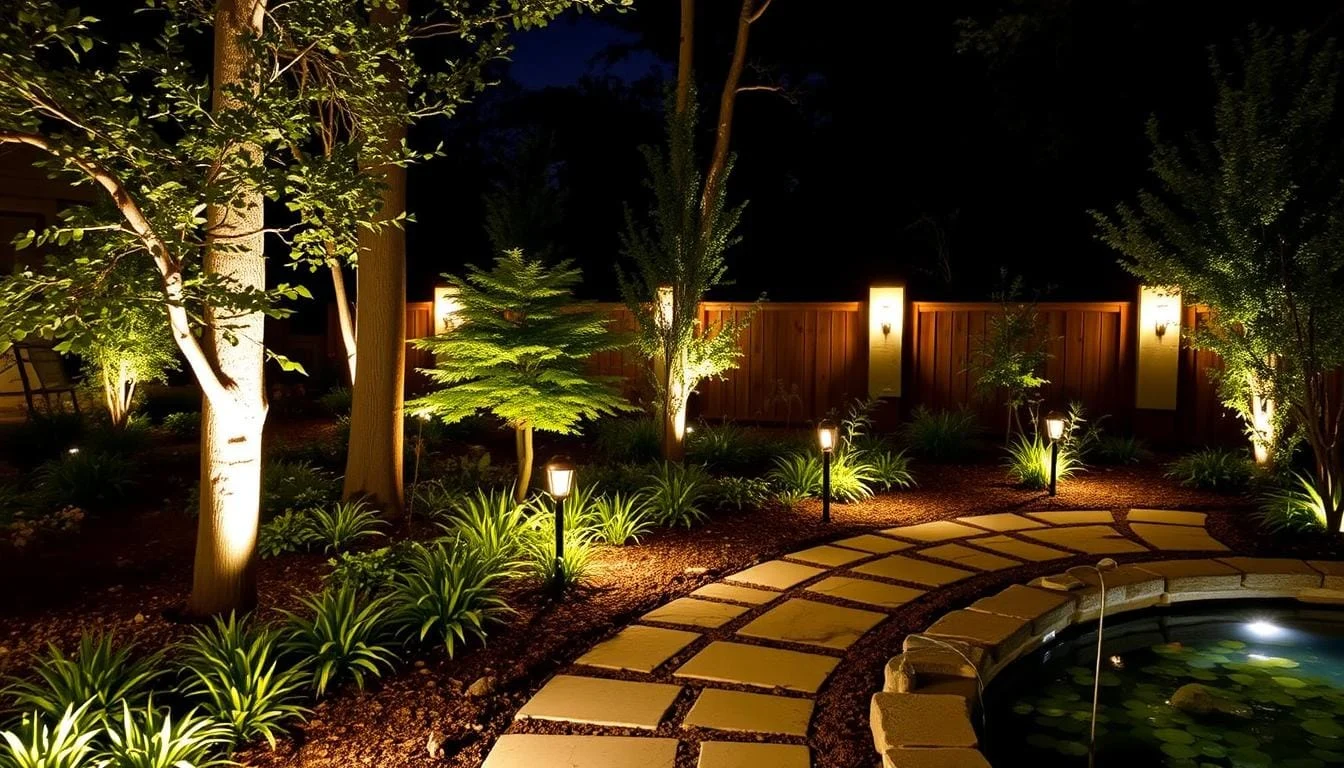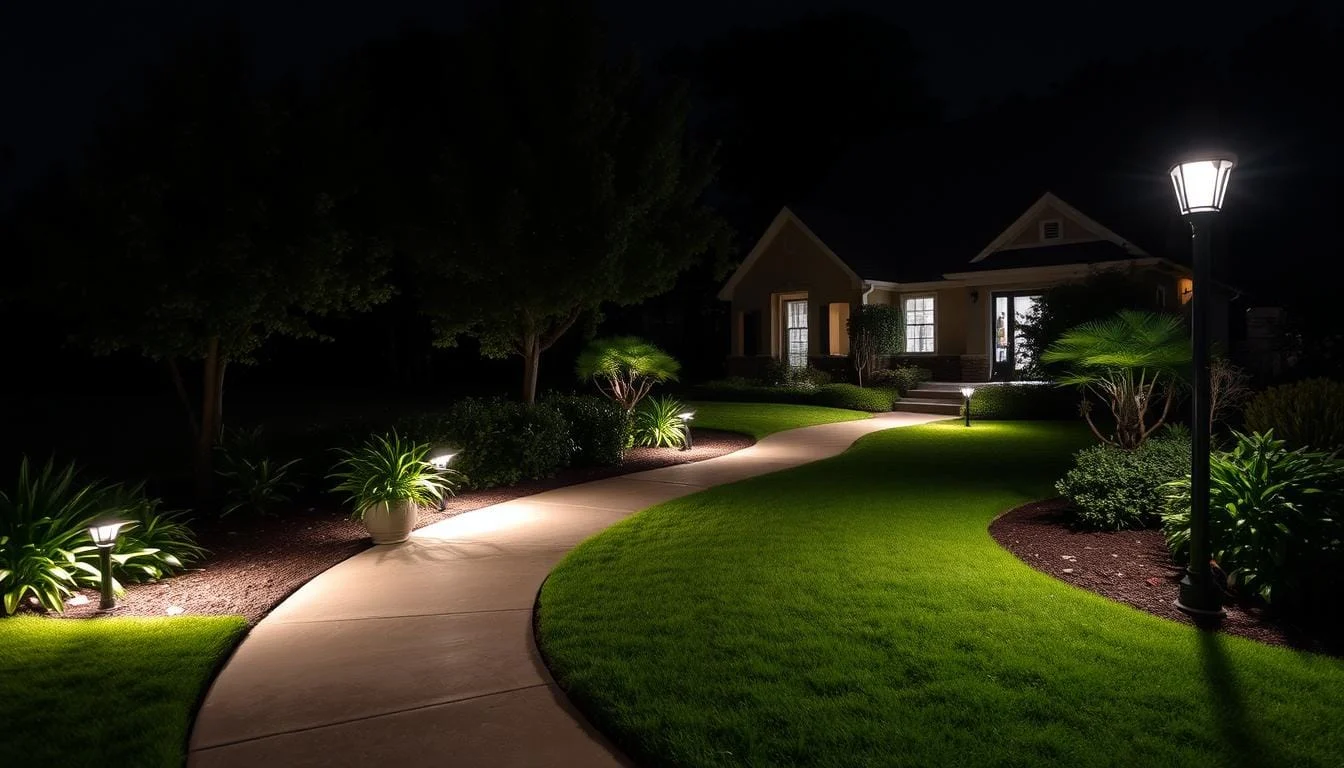Landscape lighting can turn your dark yard into a magical nighttime oasis. It illuminates outdoor spaces, showcasing your home’s best features. These systems create a warm, inviting atmosphere for relaxation and entertainment.
Outdoor lighting extends your living space beyond your walls. It transforms gardens, patios, and decks into usable areas after sunset. Well-designed lighting highlights architectural elements and beautiful plants.
Modern systems use low-voltage power, making them safe and energy-efficient. This allows for creative placement and easy adjustments. A good lighting system can enhance curb appeal and increase security.

Effective landscape lighting starts with careful planning. Consider your property’s unique features and the ambiance you want to create. Map out your home, pathways, trees, and key landscape elements.
This blueprint ensures balanced illumination that complements your home’s architecture. It helps create a thoughtful design for your outdoor lighting system.
Ready to bring your outdoor space to life after dark? Find a skilled landscape lighting designer on Fiverr to help you create the perfect nighttime ambiance for your home.
Key Takeaways
- Landscape lighting transforms outdoor spaces into nighttime retreats
- Low-voltage systems offer safety and energy efficiency
- Proper planning is crucial for effective lighting design
- LED bulbs use 75% less energy than traditional options
- Smart lighting systems allow for wireless control and pre-programmed schemes
- Various fixture types cater to different lighting needs and effects
- Professional design can enhance security, safety, and aesthetics
Understanding the Basics of Landscape Lighting
Landscape lighting enhances outdoor spaces, making them more beautiful and useful. It’s a key part of landscape design that’s worth exploring.
What is Landscape Lighting Design
Landscape lighting design is about lighting up outdoor areas. It involves planning light placement to showcase key features and improve safety.
A good outdoor lighting system can greatly improve your property’s look. It creates a welcoming atmosphere and boosts curb appeal.
The Purpose and Benefits of Outdoor Lighting
Outdoor lighting serves many purposes. It boosts security and can reduce crime by up to 39%.
It also increases property value. In fact, 90% of home buyers love outdoor lighting features.
Key Components of Lighting Systems
A good landscape lighting system has several important parts. These include transformers, cables, fixtures, bulbs, and controls.
LED bulbs are becoming the top choice. They last longer and use 75% less energy than old-style bulbs.
| Fixture Type | Recommended Lumens | Typical Use |
|---|---|---|
| Path lights | 100-200 | Walkways and garden paths |
| Flood lights | 700-1300 | Large areas and architectural features |
| Underwater lights | 200-400 | Ponds and water features |
| Motion sensor lights | 400-700 | Security and entryways |
Knowing these basics helps you create a great outdoor lighting system. For expert help, consider hiring a skilled freelancer.
How to Design Landscape Lighting
Crafting a stunning landscape lighting plan requires careful thought and precision. Start by understanding your outdoor spaces and pinpointing key elements to showcase. This process will help create a captivating nighttime ambiance.
Creating a Property Lighting Map
Sketch a detailed map of your property. Include your home, pathways, trees, and other important features. This visual guide will form the basis of your lighting plan.

Identifying Key Focal Points
Explore your property at night to spot focal points. Look for unique architectural details, special trees, or standout landscape features. These elements will become the highlights of your outdoor lighting design.
Planning Light Placement and Effects
Use your map and focal points to plan light placement. Consider various techniques to add depth and interest. These may include uplighting, wash lighting, and path lighting.
- Uplighting for trees and tall structures
- Wash lighting for walls and fences
- Path lighting for walkways and garden beds
Space fixtures carefully to achieve balanced illumination. Avoid over-lighting areas. A professional designer can help create a cohesive plan that enhances your outdoor spaces.
| Lighting Technique | Best For | Typical Wattage |
|---|---|---|
| Uplighting | Trees, architectural features | 20-50 watts |
| Path Lighting | Walkways, garden edges | 2-5 watts |
| Wash Lighting | Walls, fences | 10-15 watts |
Ready to transform your outdoor spaces? Consider hiring a skilled landscape lighting designer. They can turn your vision into a breathtaking nighttime masterpiece.
Essential Types of Landscape Lighting Fixtures
Landscape lighting makes your outdoor space beautiful and useful at night. Let’s look at key fixtures that bring your garden to life.

Garden lights, usually 18-24 inches tall, light up walkways and flower beds. They create a warm, inviting feel. Wash lights softly illuminate walls and fences, showing off textures.
Bullet lights shine a focused beam on specific features like sculptures. Well lights, installed in the ground, create dramatic uplighting on trees and tall plants.
Downlights in trees or on structures mimic moonlight, casting gentle shadows. Flood lights illuminate large areas with wide beams, great for security or big features.
| Fixture Type | Primary Use | Typical Lumens |
|---|---|---|
| Path Lights | Walkways, Garden Trails | 100-200 |
| Wash Lights | Walls, Fences | 50-300 |
| Bullet Lights | Accent Features | 50-300 |
| Well Lights | Tree Uplighting | 200-400 |
| Downlights | Moonlighting Effect | 50-300 |
| Flood Lights | Large Areas, Security | 700-1300 |
Each fixture type has a unique role in lighting design. By combining these elements, you can create a stunning nighttime landscape.
Want to enhance your outdoor space? Hire a lighting expert to design your perfect illumination plan.
Understanding LED vs. Halogen Options
Landscape lighting choices can transform your outdoor space. LED lights and halogen bulbs offer different benefits. Let’s explore their key differences to help you decide.
Benefits of LED Technology
LED lights have transformed landscape lighting with their energy efficiency. They use 80-85% less energy than halogen bulbs, cutting electricity costs significantly.
LEDs also last much longer. They can shine for 10-20 years, while halogen bulbs typically last only 1-2 years.

Cost Comparison and Efficiency
LED lights cost more upfront but save money long-term. They use about 80% less energy than halogen bulbs.
LED bulbs range from 8-16 watts, while halogen bulbs use 40-70 watts. This efficiency leads to lower energy bills and less environmental impact.
Lifespan and Maintenance Considerations
LED lights can last up to 40,000 hours, outlasting halogen bulbs by 10 times or more. This means fewer replacements and lower maintenance costs over time.
LED fixtures produce less heat, making them more durable. They also reduce the risk of damage to surrounding plants.
| Feature | LED Lights | Halogen Bulbs |
|---|---|---|
| Energy Efficiency | 80-85% more efficient | Less efficient |
| Lifespan | 10-20 years | 1-2 years |
| Wattage Range | 8-16 watts | 40-70 watts |
| Maintenance | Low | High |
| Heat Production | Low | High |
To create a stunning outdoor lighting system, seek advice from a professional landscape lighting designer. They can help you choose the perfect lighting solution for your unique space.
Low-Voltage Lighting Systems Explained
Low-voltage lighting systems brighten outdoor spaces safely and efficiently. These 12-volt systems are popular for enhancing landscape beauty and security. Homeowners love them for their ease of use and effectiveness.

The transformer is the core of a low-voltage system. It converts 120V power to a safer 12V. Choose a transformer with higher wattage than your total fixture load.
Cables connect the transformer to your fixtures. They’re buried 6 inches deep. Thicker 10 or 12-gauge wires work best for longer distances.
Fixtures and bulbs create landscape magic. Low-voltage systems offer many options, from path lights to spotlights. LED bulbs are popular for their efficiency and longevity.
Controls add flexibility to your lighting system. Timers, motion sensors, and smart home integration customize light operation. These features make your system more convenient and efficient.
“Outdoor lighting could potentially reduce severe crimes such as home robberies and murder by 36%.”
Installing a low-voltage system can be a DIY project. However, professional help ensures optimal design and installation. Consider hiring a landscape lighting expert for stunning results.
Professional Lighting Techniques and Effects
Landscape lighting can turn your outdoor space into a stunning nighttime oasis. Let’s explore key methods designers use to create captivating effects.
Uplighting and Downlighting Methods
Uplighting adds drama by illuminating objects from below. It’s ideal for showcasing trees, statues, or architectural features. Downlighting mimics moonlight, casting soft shadows and creating a romantic atmosphere.
Use downlighting to illuminate pathways or highlight garden beds. Both techniques can transform your landscape’s nighttime appearance.

Moonlighting and Shadow Effects
Moonlighting places lights high in trees to mimic moonlight filtering through branches. This technique creates a dreamy, natural ambiance. Shadow effects add depth to your landscape.
Strategic light placement casts intriguing shadows of plants or structures. These shadows can create visual interest on walls or walkways.
Path and Area Lighting Strategies
Path lighting ensures safe navigation while enhancing your landscape’s beauty. Use fixtures that direct light downward to avoid glare. Area lighting provides overall illumination for larger spaces.
Combine different techniques for a layered, professional look. This approach creates depth and visual interest throughout your outdoor area.
| Technique | Best Used For | Effect |
|---|---|---|
| Wall-Wash Lighting | Large structures | Subtle, even illumination |
| Grazing | Textured surfaces | Depth and dimension |
| In-Ground Lighting | Trees, flagpoles | Upward illumination |
| Silhouette Lighting | Unique shapes | Dramatic outlines |
Want to enhance your outdoor space with professional lighting? Consider hiring a skilled landscape lighting designer. They can bring your unique vision to life.
Safety and Security Considerations

Outdoor lighting boosts safety and security for homes. It deters burglars and improves visibility around your property. Focus on lighting pathways, entrances, and potential hiding spots.
Install pathway lighting low to the ground for better visibility. This prevents harsh glare while illuminating walkways. Motion-activated lights offer extra protection against intruders.
Here are some tips for outdoor lighting safety:
- Use a variety of lights with different angles, colors, and intensities
- Illuminate the front elevation of your home for balance
- Install lighting in phases or zones for better control
- Regularly clean and maintain your lighting system
Low-voltage landscape lighting systems are highly energy-efficient. They use up to 90% less energy than traditional options. These systems are safer too, with a lower risk of electrical shock.
For expert installation and advice, hire a skilled freelancer. They can design a secure and beautiful landscape lighting system for you.
“Proper outdoor lighting not only enhances the beauty of your landscape but also creates a safer environment for your family and guests.”
Color Temperature and Brightness Guidelines
Color temperature and brightness are key to creating perfect outdoor ambiance. Kelvin ratings, lumens, and wattage help craft stunning landscape lighting designs.
Choosing the Right Kelvin Rating
Color temperature, measured in Kelvins (K), affects your outdoor space’s mood. Warmer temperatures (2700K-3000K) create a cozy atmosphere for patios and entertainment areas.
Cooler temperatures (4000K-5000K) offer better visibility for driveways and security lighting. For general landscape lighting, consider 3000K soft white LEDs.
Understanding Lumens and Wattage
Lumens measure brightness, while wattage indicates energy use. Path lighting needs 100-200 lumens. Accent lighting requires 50-300 lumens.
Flood lights need 700-1300 lumens for optimal illumination. LED lights use less wattage than halogen bulbs, making them more energy-efficient.
Creating Mood with Light Color
Different color temperatures set the right mood in your landscape. Warm white (2700K) LEDs create a welcoming atmosphere in outdoor living spaces.
Neutral white (3000K-4000K) LEDs enhance plant and architectural feature colors in gardens. Cool white (5000K-6500K) works well for security lighting and large areas.
Need expert help with your landscape lighting design? Find skilled freelancers specializing in outdoor lighting solutions to bring your vision to life.
FAQ:
For “Everything You Need to Know About Landscape Lighting Design Systems”
Q: What are the benefits of landscape lighting?
A: Landscape lighting offers numerous benefits, including enhanced curb appeal, improved safety and security, extended outdoor living hours, and increased property value. It can highlight architectural features, create ambiance, and illuminate pathways, making your outdoor spaces more functional and aesthetically pleasing.
Q: What types of outdoor lighting areas should I consider?
A: When planning your landscape lighting design, consider illuminating key areas such as pathways, entryways, trees and plants, water features, outdoor living areas, and architectural elements. Each of these lighting areas serves a specific purpose and contributes to the overall ambiance of your outdoor space.
Q: What are some popular landscape lighting techniques?
A: Some popular landscape lighting techniques include uplighting, downlighting, path lighting, spotlighting, and moonlighting. Each technique creates a different effect and can be used to highlight specific features or create a desired ambiance in your outdoor space.
Q: What types of bulbs are best for landscape lighting?
A: LED bulbs are highly recommended for landscape lighting due to their energy efficiency, long lifespan, and durability. They produce less heat than incandescent bulbs and come in various color temperatures to create the desired atmosphere. Low-voltage LED lighting systems are particularly popular for their safety and ease of installation.
Q: How do I install landscape lighting?
A: While some homeowners opt for a DIY landscape lighting project, it’s often best to hire landscape lighting professionals for installation. The process typically involves planning the layout, running low-voltage wiring, installing transformers, and placing fixtures. A lighting professional can ensure proper voltage drop calculations and create a landscape lighting design that meets your specific needs.
Q: What are some landscape lighting tips for creating an effective design?
A: Some helpful landscape lighting tips include: using a variety of lighting techniques, considering the color temperature of your light bulbs, avoiding over-lighting, incorporating controls like timers or smart systems, and planning for future expansion. Remember that less is often more when it comes to creating a subtle and elegant lighting design.
Q: How do I maintain my landscape lighting system?
A: Landscape lighting maintenance involves regular cleaning of fixtures, checking and replacing bulbs as needed, ensuring proper voltage, and trimming vegetation around lights. It’s also important to periodically adjust your lighting design over time as your landscape grows and changes. For more complex systems, consider scheduling annual maintenance with a lighting professional.
Q: How can landscape lighting design enhance outdoor living spaces?
A: Landscape lighting can transform your outdoor living areas into inviting spaces for evening relaxation and entertainment. By illuminating patios, decks, and seating areas with soft light, you create a warm and welcoming atmosphere. Lighting can also highlight features like outdoor kitchens, fire pits, and water features, making these areas more functional and enjoyable after dark.
Q: What should I consider when hiring a landscape lighting designer?
A: When hiring a landscape lighting designer, consider their experience, portfolio of past projects, knowledge of different types of outdoor lighting, and ability to create a custom design that meets your specific needs and budget. A good designer should be able to provide a detailed lighting plan, explain the installation process, and offer guidance on maintenance and future upgrades to your outdoor lighting system.
Source Links
- Landscape lighting installation transforms ordinary spaces into extraordinary nighttime wonderlands.
- How to Light a Landscape | Every light source tells a story of how you want to light up your environment.
- Used to illuminate the most beautiful aspects of your property, types of lights have revolutionized outdoor design.
- Your outdoor lighting guide to creating magical spaces starts here!
- Lighting has come a long way, revealing stunning possibilities in landscape lighting areas.
- Landscape Lighting Guide and Tips | Discover the right lighting that makes your lighting on your property truly spectacular.
- Lighting can really transform your outdoor experience.
- Design your landscape lighting with creativity, exploring many landscape lighting techniques that use light in innovative ways.
- Types of Landscape Lighting
- From classic incandescent lighting to modern solutions, learn to keep your outdoor spaces brilliantly alive.
- Maximize the use of your outdoor environment with strategic landscape spotlights.
- Create new perspectives with pools of light that dance across your landscape.
- What Is Low Voltage Landscape Lighting and How Does It Work?
- Each carefully crafted beam of light allows you to direct the light precisely where you want it.
- Used to light architectural features and natural beauty, your lighting design becomes an art form.
- The design process involves understanding how to lower voltage systems and prevent voltage issues.
- Landscape Lighting Ideas For Enhancing The Safety & Ambiance
- Cast light that complements the existing natural light, creating a seamless transition between day and night.
- How to Install Landscape Lighting: 10 Safe & Easy Steps
- LED color temperature for outdoor lighting — KELVIN Landscape Lighting
- What Is the Best LED Color Temperature For Outdoor Lighting?
Related Articles:
- Freelance Graphic Design Rates for Poster Design: 2025 Pricing Guide
- Custom Restaurant Menu Printing & Design Services Near Me
- Custom Illustration Design Services for Unique Brand Identity
- 10 Best Freelance Cartoonists for Hire: Top Comic Artists & Illustrators in 2025
- Understanding the Role of a Building Engineer vs. Structural Engineer
- 7 Principles of Landscape Design: A Complete Guide
- Architecture vs Interior Design: Understanding Interior Architecture Differences
- Create NFT Art: A Step-by-Step Guide to Make Your Own NFT Token
- What is Storyboard and Why is it Important? | Using Storyboards for Filmmaking
Our Partners: CSKDesignCrafts.com – FitFusioHub.com – LifeCraftsCentre.com
This post contains affiliate links, which means I may earn a commission if you make a purchase through these links. There is no additional charge to you! Thank you for supporting my blog so I can continue creating free content each week!




